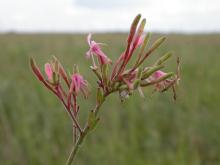Wildflowers, Grasses and Other Nonwoody Plants
Media
Species Types
Scientific Name
Vernonia baldwinii
Description
Ironweeds are tough, grayish-green, branching plants known for their fluffy-looking clusters of reddish-purple florets. They are a familiar sight on roadsides and pastures. Identify western ironweed by the bracts at the base of the flowerheads.
Media

Species Types
Scientific Name
Hibiscus lasiocarpos
Description
Hibiscus in Missouri? You bet! Hairy rose mallow is a native perennial whose 6-inch-wide blossoms look a lot like those of its tropical relatives. The stalks can get woody and can grow to 8 feet tall.
Media

Species Types
Scientific Name
Physostegia virginiana
Description
False dragonhead is called "obedient plant" because when you push one of the flowers sideways, it "obediently" stays in place for a while.
Media

Species Types
Scientific Name
Cardamine bulbosa
Description
Like many of its relatives in the mustard family, spring cress has a bitter or pungent flavor, similar to horseradish. It is sometimes used as a condiment and in salads. Or you could just enjoy the pretty white flowers!
Media

Species Types
Scientific Name
Blephilia ciliata
Description
Square, unbranching stems, opposite leaves, two-lipped flowers, and a mild minty fragrance are clues Ohio horsemint is in the mint family. Tight, rounded flower clusters are stacked atop one another at the stem tips.
Media

Species Types
Scientific Name
Lippia lanceolata (formerly Phyla lanceolata)
Description
Common in almost any kind of moist, wet or muddy habitat, fog fruit bears interesting round, purple flower heads that are ringed by small, white or pinkish flowers.
Media

Species Types
Scientific Name
Oenothera filiformis (formerly Gaura longiflora, G. biennis)
Description
Large-flowered gaura is a tall plant whose white flowers turn pinkish as they age. Four petals point upward, then bend back, and 8 stamens droop downward. The flowers look something like small butterflies.
Media
Species Types
Scientific Name
Erigeron philadelphicus
Description
The antique belief that this plant might repel fleas gives the fleabanes their name. There are more than 170 fleabanes in the genus Erigeron in North America. This one is scattered to common nearly throughout Missouri. Native Americans used this species medicinally for a variety of ailments.
Media

Species Types
Scientific Name
Lobelia cardinalis
Description
Cardinal flower provides a splash of bright red along streams and rivers, in bottomland forests, in ditches by roads, and in other wet places. It's a long-blooming Missouri native wildflower.
Media

Species Types
Scientific Name
Symphyotrichum spp. (formerly Aster spp.)
Description
Missouri has 24 species of New World asters in genus Symphyotrichum. Most have purple or white ray flowers and yellow disk flowers that turn reddish over time. Most bloom in late summer and fall.
See Also
About Wildflowers, Grasses and Other Nonwoody Plants in Missouri
A very simple way of thinking about the green world is to divide the vascular plants into two groups: woody and nonwoody (or herbaceous). But this is an artificial division; many plant families include some species that are woody and some that are not. The diversity of nonwoody vascular plants is staggering! Think of all the ferns, grasses, sedges, lilies, peas, sunflowers, nightshades, milkweeds, mustards, mints, and mallows — weeds and wildflowers — and many more!





















